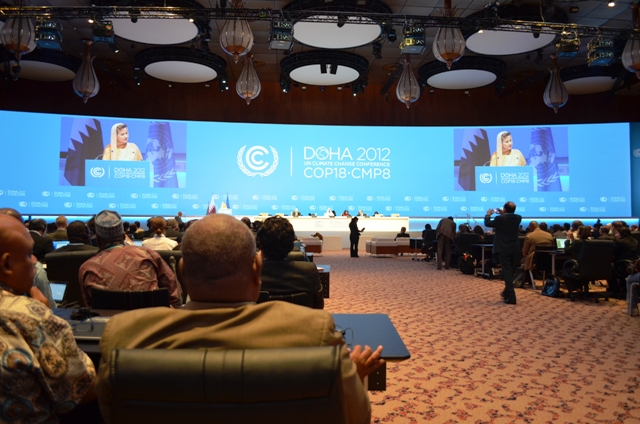
26 November 2012, Doha Qatar, UNFCCC COP 18 - Pacific island countries are calling for a second five-year commitment period under the Kyoto Protocol. They unite with the Alliance of Small Island States (AOSIS) in Doha, Qatar to negotiate this as the first commitment period runs out at this end of this year.
“What we need as of the 1st of January, in a few weeks time, is we need to see credible second commitment reduction levels, as the key to our survival in the Pacific is an ambitious reduction in greenhouse gas emissions,” said H.E Ambassador Colin Beck, the UN representative from the Solomon Islands.
“I think the problem facing the Pacific is beyond the Pacific to address, it needs a global solution and this is where we need to work with everybody that wants to work to save humanity.”
 Ambassador Colin Beck on Right with the Solomon Islands delegation
Ambassador Colin Beck on Right with the Solomon Islands delegation
A second commitment period under the Kyoto Protocol will help bring the level of greenhouse gas emissions to a peak before the year 2020 to limit global warming below 1.5 degrees, the goal behind the Alliance of Small Island States.
The Kyoto Protocol is an international agreement under the United Nations Framework to the Convention on Climate Change (UNFCCC). It legally binds industrialized countries to reduce their greenhouse gas emissions by 5% below the 1990 level between the five-year commitment period of 2008 to 2012.
The 1990 level is that of the greenhouse gas emissions recorded in the year 1990 and the five-year period 2008 to 2012 is the first commitment period.
Negotiations opened today in Doha, Qatar at the 18th Conference of the Parties to the UNFCCC, it has already been a busy week for the Pacific as they strategise and plan a way forward as part of the Alliance of Small Island States (AOSIS).
 Opening plenary in Doha
Opening plenary in Doha
“It was agreed in the Kyoto Protocol that there would be future commitment periods with the second one starting in 1 January next year,” said Ms. Diane McFadzien, the Climate Change Adaptation Adviser at the Secretariat of the Pacific Regional Environment Programme (SPREP).
“A second commitment period provides certainty. While there are countries that have made voluntary pledges to reduce their greenhouse gas emissions, having a second commitment period under the Kyoto Protocol provides an official verification and measurement system in place to work with the countries reducing their emissions.”
The Kyoto Protocol became a legally binding treaty on 16 February 2005, it came into force after two conditions were met; it was ratified by a minimum of 55 countries and; it has been ratified by nations accounting for at least 55% of emissions from what the Protocol calls “Annex 1” countries – 38 industrialised countries given targets for reducing emissions, plus Belarus, Turkey and now Kazakhstan.